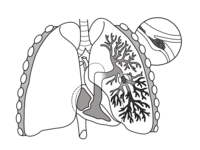
Photo from wikipedia
Background Anti-Embolism (AE) devices therapy is an additional antithrombotic treatment that is effective in many venous diseases, but the correlations between this medical compression therapy and cardiovascular arterial disease or… Click to show full abstract
Background Anti-Embolism (AE) devices therapy is an additional antithrombotic treatment that is effective in many venous diseases, but the correlations between this medical compression therapy and cardiovascular arterial disease or comorbid diabetes mellitus (DM) are still controversial. In this study we investigated the association between compression therapy and intensive care unit (ICU) mortality in patients with a first acute myocardial infarction (AMI) diagnosis complicated with type II DM. Methods This retrospective cohort study analyzed all patients with AMI and type II DM in the Medical Information Mart for Intensive Care-IV database. We extracted the demographics, vital signs, laboratory test results, comorbidities, and scoring system results of patients from the first 24 h after ICU admission. The outcomes of this study were 28-day mortality and ICU mortality. Analyses included Kaplan–Meier survival analysis, Cox proportional-hazards regression, and subgroup analysis. Results The study included 985 eligible patients with AMI and type II DM, of who 293 and 692 were enrolled into the no-AE device therapy and AE device therapy groups, respectively. In the multivariate analysis, compared with no-AE device therapy, AE device therapy was a significant predictor of ICU mortality (HR = 0.48, 95% CI = 0.24–0.96, P = 0.039) and 28-day mortality (HR = 0.50, 95% CI = 0.27–0.90, P = 0.021). In addition to age, gender and coronary artery bypass grafting surgery, there were no significant interactions of AE device therapy and other related risk factors with ICU mortality and 28-day mortality in the subgroup analysis. Conclusions Simple-AE-device therapy was associated with reduced risks of ICU mortality and 28-day mortality, as well as an improvement in the benefit on in-hospital survival in patients with AMI complicated with type II DM.
Journal Title: Frontiers in Cardiovascular Medicine
Year Published: 2022
Link to full text (if available)
Share on Social Media: Sign Up to like & get
recommendations!